Rhondda Tramways
History
Rhondda Urban District Council acquired powers to build an electric tramway system as early as 1902, though its enabling act prohibited it from operating the tramway itself.
The council officially became a tramway owner on the 31st October 1904, when it compulsorily purchased — along with Pontypridd Urban District Council — the tracks and assets of the defunct Pontypridd and Rhondda Valley Tramway Company, a 3ft 6ins-gauge horse tramway. The P&RVTCo, which was owned by the British Electric Traction Company, had wanted to build an electric tramway system in the Rhondda Valley, but had been forced to give up in the face of concerted opposition from the two councils, both of which had plans for their own tramways.
Rhondda UDC eventually reached an agreement — with the National Electric Construction Company Limited — for them to build and operate the council's planned 3ft 6-ins gauge electric tramway, and to this end, a subsidiary company was set up on the 14th April 1906, the Rhondda Tramways Company Ltd. The NECCo also went on to either lease or own five other tramways: City of Oxford Tramways (1907-1914); Dewsbury, Ossett & Soothill Nether Tramways (1908-1931); Mexborough & Swinton Tramways (1907-1929); Musselburgh and District Tramways (1904-1932) and Torquay Tramways (1907-1934). It eventually sold out to the British Electric Traction company (in 1931), a concern which over the course of its history, either owned, part-owned or leased almost 50 tramway across the British Isles.
The first electric tramway services finally commenced on the newly built system on the 11th July 1908, fully six years after the council had acquired the powers to build it; it is currently unclear why it took so long. The system initially consisted of a line running westwards from Trehafod to Porth, where it divided, one line running westwards then northwards up the Rhondda Fawr to Partridge Rd, and the other running northwards up Rhondda Fach to Pont-y-Gwaith. The former was extended northwestwards through Pentre to Treherbert in September 1908, and onto Tynewydd in March 1915, whilst the latter was extended northwestwards to Ferndale and Maerdy in 1912. A subsidiary route along the Rhondda Fawr from Porth to Partridge Road, but travelling on the opposite side of the valley via Tonypandy, was opened in November 1908, with a branch off it southwards to Williamstown opening in March 1912. At its maximum, the system totalled 20.92 miles. Although it was connected at Trehafod to Pontypridd UDC Tramways, it was not until the 14th July 1919 that through running commenced (mainly between Pontypridd and Porth) only to stop again in December 1927, both parties managing to disagree on just about everything possible in the 8 years that the services ran.
The system was very heavily used, particularly in transporting miners to work and people between the towns along the heavily populated valleys. This was however a double-edged sword, miners' strikes having a disproportionate impact on income (particularly in 1921 and 1926), whilst mining subsidence was an ever-present fact of the tramway's life, with the company incurring very high maintenance costs as it fought a never-ending battle to keep the trams on the rails.
The tramway doubtless emerged from the Great War in run-down condition, following four years of minimal maintenance and severe restrictions imposed on procurement of rails and/or tramcars. No new tramcars were purchased after the war, but rebuilding of existing cars did take place, along with top-covering of open-topped vehicles.
Financial details of the tramway company are unknown, but it probably made a healthy profit judging by the RTCo's unsuccessful offer to lease the Pontypridd UDC Tramway system in October 1923.
The company experimented fairly disastrously with trolleybuses in 1914/15, having to withdraw them after only three months due to a runaway, as well as the damage the vehicles were sustaining from the poorly maintained roads.
The company introduced buses in August 1920, steadily expanding the fleet and the services throughout the decade. The success of these services, compared with the high cost of trying to keep the tramway in order, coupled with the life-expired tramway fleet (by the early 1930s), inevitably led to the decision to abandon the tramway in favour of buses (in agreement with RUDC). The Rhondda Fawr routes closed on the 31st December 1933, to be followed only one month later by the Rhondda Fach route, the last tram running on the 1st February 1934.
Uniforms
Photographs of Rhondda Tramways staff are very thin on the ground, so it is only possible to paint a superficial picture of the tramway's uniform story.
Photographs suggest that motormen were issued with double-breasted lancer-style tunics with five pairs of buttons (narrowing from top to bottom), epaulettes and stand-up collars; conductors on the other hand were issued with double-breasted jackets with four pairs of buttons and lapels. Assuming that later photographs accurately reflect earlier practice, then the collars of these jackets would have borne system initials — R T C — on the bearer's right-hand side and an employee number on the left-hand side. To date, no marked buttons have come to light — as is the case for all the tramway systems owned by the NECCo, the RTCo's parent company — so in all likelihood they were plain. The tensioned-crown peaked caps carried standard, off-the-shelf, script-lettering grade badges — either Motorman or Conductor — though whether these were brass or nickel is currently unknown.
By the 1920s, conductors were being issued with single-breasted jackets with four pockets, epaulettes (with button closures) and stand-up collars; the latter definitely carried an employee number on the bearer's left-hand side and individual 'R T C' initials on the right-hand side.
Motorman and conductors were also issued with double-breasted greatcoats with high, fold-over collars; these garments appear not to have borne any insignia.
It is currently unclear whether a switch was made to British Electric Traction Company uniforms in 1931, following the latter's takeover over the RTCo's parent company, the National Electric Construction Company.
A single photograph of an inspector has survived, from early on in the system's life; this indicates that they were issued with fairly standard 'tramway' uniforms for this grade, comprising single-breasted jackets with hidden buttons (or more likely a hook and eye affair), all edged in material of a finer quality than the main jacket. The jackets had upright collars which bore insignia of some kind, most probably the grade — Inspector — or system initials. Caps were in a military style, and most probably bore a script-lettering Inspector badge on a hat band, again probably embroidered.
It is entirely possible that the RTCo employed female staff during the Great War to replace male staff lost to the armed forces, as well as the better-paying mines; however, photographs appear not to have survived, so it is currently impossible to state what they wore, or indeed, whether they were even employed at all.
Further reading
For a short history of the Rhondda Tramways, see: 'The Directory of British Tramways' by Keith Turner; Patrick Stephens Limited (1996).
Images
Motormen and conductors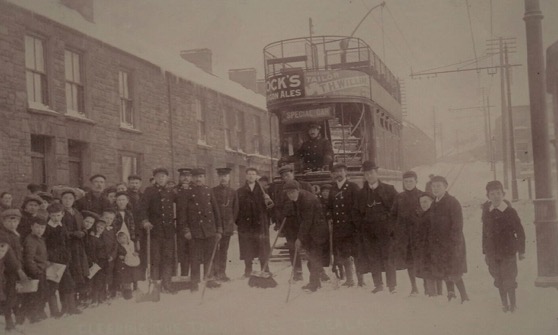
An unidentified open-topped tram aids snow clearing in Trealaw — photo undated, but probably taken in the late Edwardian era. Two of those snow-clearing are wearing 'lancer-style' tunics, suggesting that this style of tunic was that first issued. Source unknown.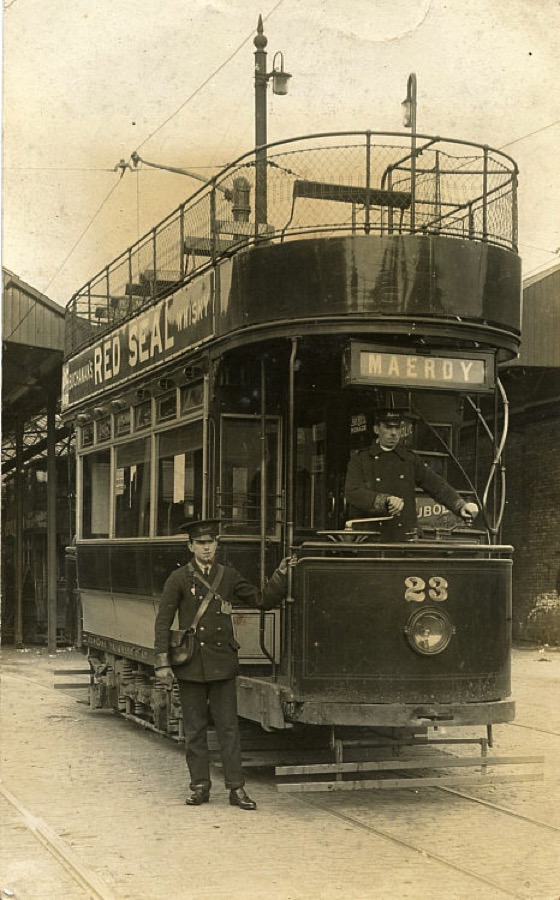
The crew of Tramcar No 23 pose for the cameraman outside the depot at Troedyrhiw Rd, Porth — photo undated, but certainly taken after 1912 when the Rhondda Fach route was extended to Maerdy. Author's Collection.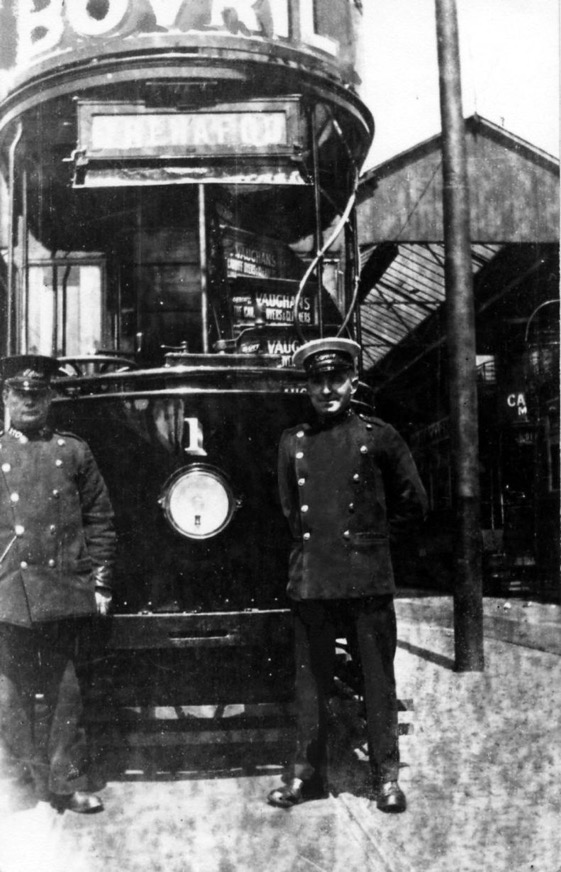
Two motormen pose with a highly polished Tramcar No 1 at Porth Depot — photo undated, but probably taken before through-running to Pontypridd commenced in 1919. Both men are wearing lancer-style jackets. Source unknown. 
Standard off-the-shelf script-lettering grade badges of the type used by the Rhondda Tramways Company — brass. It is currently unclear what material the RTC actually used, though it would have been either nickel or brass. Author's Collection.
The crew of a rather tatty-looking Tramcar No 30 pose for the cameraman — photo undated, but probably taken in the early 1920s. Once again, and in contrast to the motorman, who is wearing a lancer-style tunic, the conductor is wearing a double-breasted jacket with lapels. The latter would also appear to be wearing a badge above his script-lettering grade badge.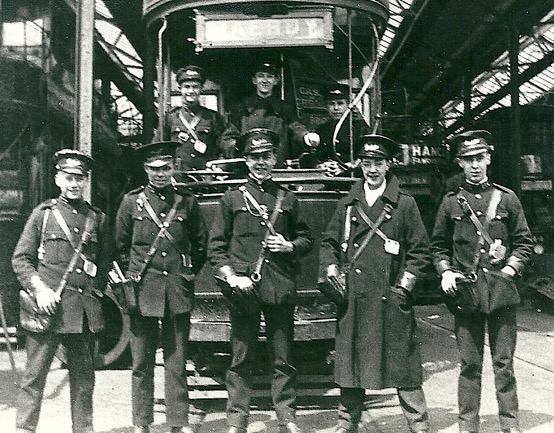
Another depot shot, this time of a host of some extremely youthful-looking conductors — photo again undated, but possibly taken in the late 1920s or early 1930s. Photo courtesy of Trevor Thomas.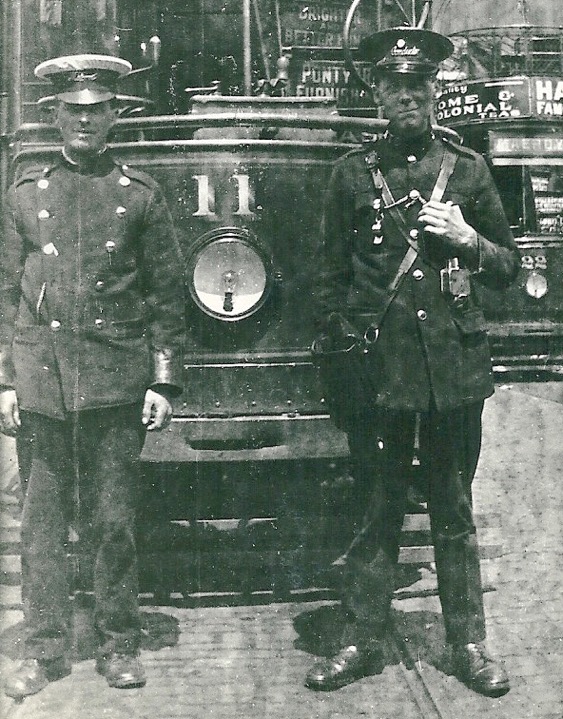
A depot photograph of the motorman and conductor of Tramcar No 11 — photo undated, but probably taken in the 1920s or early 1930s. Photo courtesy of Trevor Thomas.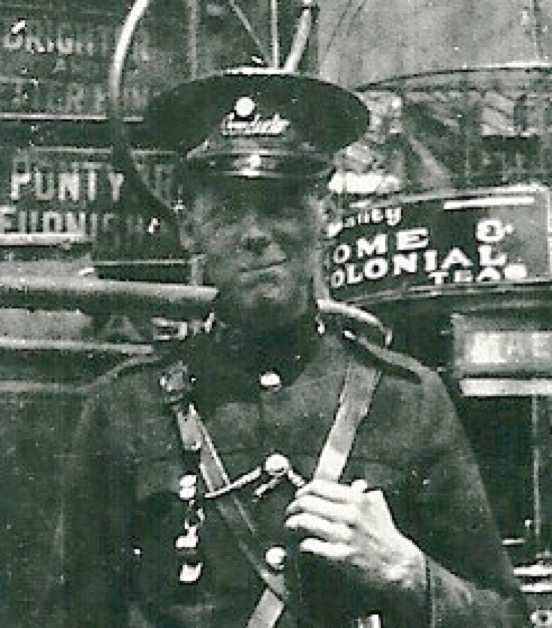
A blow-up of the above photo showing the conductor — his right-hand collar bears the company's initials: 'R T C'. The round badge is probably not official, as it is absent from all other known photographs.
Senior staff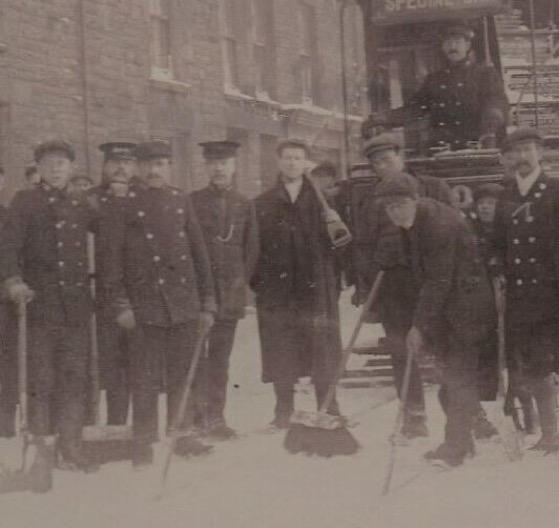
A blow-up of the snow-clearing scene above showing an inspector (fourth from the left).